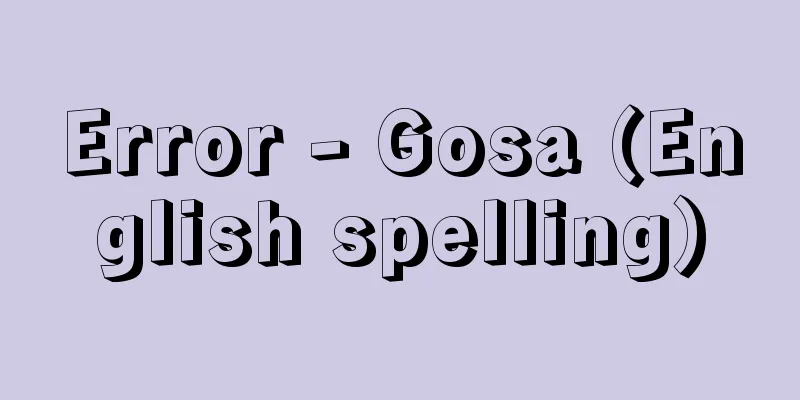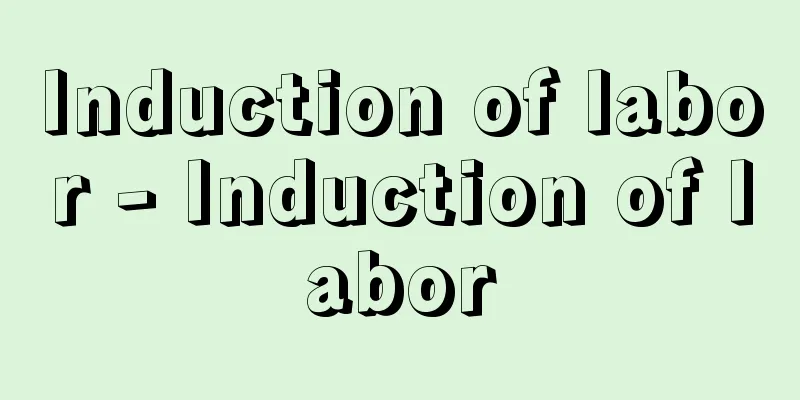Error - Gosa (English spelling)

|
When making measurements or calculations, what we really want to know is the true value (exact value), but in reality, we often only get a value close to it (an approximate value). The difference between the two is called the error. When expressing it with a sign, it is normal to take the larger approximate value as a positive value (an overapproximation). Expressed as a formula, it is as follows: (approximate value) - (true value) = (error) Measure of errorTo express the magnitude of the error, the absolute value of the above value (called the absolute error) can be used as is, but it is sometimes more appropriate to express it as a percentage of the true value. This is called the relative error. | (approximate value) - (true value) | = (absolute error) [Hayato Togawa] The nature of the errorThere are errors that have a pattern and errors that are completely random (irregular). Of these, errors that have a pattern can often be corrected with sufficient investigation. However, because there are many different causes, countermeasures must be taken on a case-by-case basis. Irregular errors may seem like nothing can be done at first glance, but in many cases the errors follow a certain probability distribution. This distribution is called normal distribution or Gaussian distribution. The properties of this type of error can be studied using probability theory, and it is known, for example, that "if you measure the same thing N times and take the average, the expected error in the average will be 1/the original error." [Hayato Togawa] Error PropagationWhen calculations are performed on data that contains errors, errors will also be introduced into the result. The following can be said about the effects this has: When adding or subtracting, the absolute error becomes the sum of the original errors. The relative error usually does not change much, but when adding two numbers with opposite signs and nearly equal absolute values, the relative error increases sharply. This is called "cancellation of significant digits." The relative error in the result of multiplication or division is nearly equal to the sum of the relative errors of the original values. However, if the relative error in the divisor is large, the error can be significantly magnified. If an equation's coefficients or constant terms contain errors, errors will be introduced into the solution to the equation. The magnitude of this effect depends on the properties of the equation. If a small error has a large effect on the result, it is said to be ill-conditioned. [Hayato Togawa] Numerical calculation errorErrors in numerical calculations can be broadly divided into rounding errors and truncation errors. Rounding errors occur when numbers are handled with a finite number of digits. Truncation errors occur when approximating the sum of an infinite series with the sum of a finite number of terms, when stopping the iterations of a successive approximation method midway, or when approximating calculus discretely. [Hayato Togawa] "Fundamentals of Error Analysis" by Togawa Hayato (1974, Science Press)" ▽ "Rounding Error Analysis in Basic Arithmetic" by Wilkinson, translated by Ichimatsu Makoto and Shijo Tadao (1974, Baifukan)" ▽ "Computers and Numerical Analysis" by Nagasaka Hideko (1980, Asakura Publishing)" ▽ "New Error Theory - Experimental Data Analysis Method" by Yoshizawa Yasukazu (1989, Kyoritsu Shuppan)" ▽ "Numerical Computation with Guaranteed Accuracy" by Oishi Shinichi (2000, Corona Publishing) [Reference] | | |Source: Shogakukan Encyclopedia Nipponica About Encyclopedia Nipponica Information | Legend |
|
測定をしたり計算をしたりするとき、本当に知りたいのは真値(厳密値)であるが、実際にはそれに近い値(近似値)しか得られないことが多い。両者の差を誤差という。符号をつけて表すときは、近似値のほうが大きい場合(過大近似値の場合)をプラスにとるのが普通である。式で表せば次のようになる。 (近似値)-(真値)=(誤差) 誤差の尺度誤差の大きさを表すには、前記の値の絶対値(これを絶対誤差という)をそのまま用いてもよいが、真値に対する割合で表すほうが適当なこともある。これを相対誤差という。 |(近似値)-(真値)|=(絶対誤差) [戸川隼人] 誤差の性質誤差には、規則性のあるものと、まったく不規則(ランダム)なものとがある。このうち、規則性のあるものに関しては、十分に調べれば補正できることが多い。ただし、原因は多種多様なので、対策はケース・バイ・ケースである。不規則な誤差に関しては、一見どうしようもないように思えるが、多くの場合、誤差がある種の確率分布に従う。この分布は正規分布またはガウス分布とよばれている。この種の誤差については確率論を用いて性質を研究することができ、たとえば「同じものをN回測定して平均すれば、平均値の誤差の期待値は元の誤差の1/になる」ということなどが知られている。 [戸川隼人] 誤差の伝播誤差を含むデータに計算処理を行うと、計算結果にも誤差が入る。その影響に関しては次のようなことがいえる。加減算すると絶対誤差は元の誤差の和になる。相対誤差は、普通はあまり変わらないが、符号が反対で絶対値がほぼ等しい二つの数を加えるような場合には相対誤差が急増する。これを桁(けた)落ちという。乗除算結果の相対誤差は、元の値の相対誤差の和にほぼ等しい。ただし除数の相対誤差が大きい場合には、誤差が著しく拡大されることがある。方程式の係数や定数項に誤差が含まれていると、方程式の解に誤差が入る。その影響の大小は方程式の性質によって決まる。わずかの誤差が結果に大きな影響を与えるならば、悪条件ill-conditionであるという。 [戸川隼人] 数値計算の誤差数値計算における誤差には大別して丸めの誤差と打ち切り誤差がある。丸めの誤差は数値を有限桁数で扱うために生ずる。打ち切り誤差は、無限級数の和を有限項の和で近似したり、逐次近似法の反復を途中で打ち切ったり、微積分を離散的に近似したりする際に生ずる。 [戸川隼人] 『戸川隼人著『誤差解析の基礎』(1974・サイエンス社)』▽『ウィルキンソン著、一松信・四条忠雄訳『基本的演算における丸め誤差解析』(1974・培風館)』▽『永坂秀子著『計算機と数値解析』(1980・朝倉書店)』▽『吉沢康和著『新しい誤差論――実験データ解析法』(1989・共立出版)』▽『大石進一著『精度保証付き数値計算』(2000・コロナ社)』 [参照項目] | | |出典 小学館 日本大百科全書(ニッポニカ)日本大百科全書(ニッポニカ)について 情報 | 凡例 |
<<: Tatami mat (mat) - Tatami mat
Recommend
Mikisaburo Rai - Mikisaburo Rai
A patriot of the Sonnjo (revere the expulsion of ...
Spyri, Johanna
Born June 12, 1827 in Hirzel, near Zurich Died: Ju...
Cyst nematode - Cyst nematode
A general term for nematodes of the Heteroderinae ...
Nielsen, A. (English spelling) NielsenA
…Just as Italy created the screen diva and became...
Stretch reflex
This is a reflex that occurs when a pulling force ...
Stepanov, VI (English spelling)
...After that, various dance notation methods wer...
Penthesileia
…As a result, the Amazons attacked Athens, but we...
Défense (English spelling)
This is the central area of the new urban develo...
Laurencia undulata (English spelling) Laurencia undulata
…[Mitsuo Chihara]. . . *Some of the terminology t...
Unagitsukami - Eel Grabber
An annual plant of the Polygonaceae family that gr...
Guru - Kyoso
A religious leader who founded a religion or reli...
Ibykos (English spelling)
A Greek lyric poet from the mid-6th century BCE. H...
Monkey wrench (English spelling)
A type of wrench, named after the shape of its hea...
Médoc (English spelling)
The name of a region in southwestern France, occup...
Oak net - Oak net
… A set net is a long, thin bag net or a set net ...



![Asahidake [Hot Spring] - Asahidake](/upload/images/67cf27277fdc8.webp)





